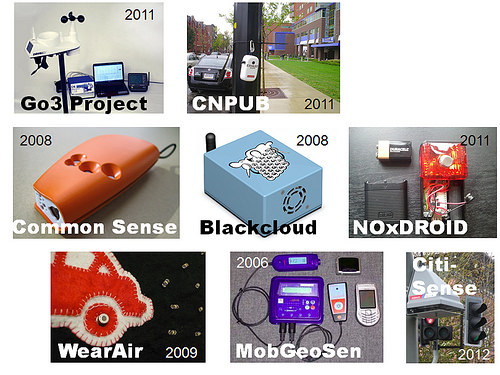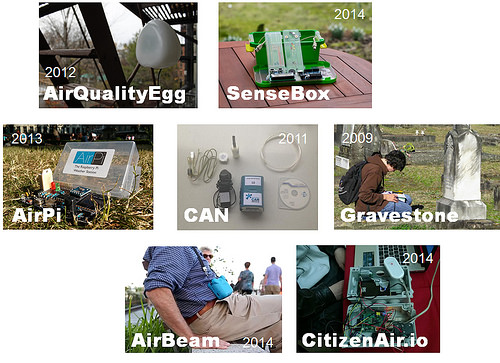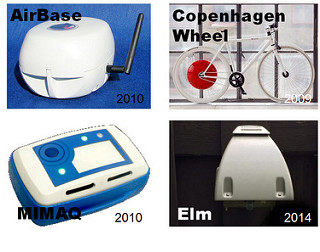
Photo by kozumel
Before I start, let me just say I am not particularly focused on air quality when it comes to citizen sensing. I believe citizen sensing can be applied to a number of questions including biodiversity, land usage, energy or waste. It just so happens that I had picked air quality back in 2010 when I took my course on Sustainable Development as an example to show what citizen sensing was all about.
As 2014 comes to an end and my last post dates back to 6 months ago, I thought it would be nice to revisit some air quality projects. I tracked a variety of projects - commercial, research and community - for outdoor and indoor in urban ecosystems. In this post, I’ll just focus on urban sensing only. The list does not attempt to be exhaustive. Research projects to me are projects initiated in the context of schools or universities, e.g. computer-human interaction students or schools. Commercial projects will sell a sensor and community projects are open to any citizen able to dedicate some time assembling a sensor before joining the party.
Research Projects

One project, MobGeoSen, goes back to 2006. It encouraged school children to learn more about their environment whilst doing everyday activities. Pupils in Bath (UK) were given a phone and a portable sensor to monitor pollution levels on their journey to school over a period of two weeks.
BlackCloud in 2008 is one of my favorites. I had posted previously about Greg Niemeyer’s hyper-local air quality sensor network and fictional game narrative to evaluate the pedagogical potential of alternate reality games for high school students in Los Angeles. It was organized as 7 challenges over 35 days including puzzle lock, scavenger hunt, twitter activities, daily polluter reporting, seed bombs, pollution taxonomy, and ecotopia postcards. Another reference in this space is Eric Paulos’ joint efforts with Intel in Common Sense. It consisted of a distributed air quality monitoring system, which combined handheld environmental air quality monitors with a browser-accessible web portal. Unfortunately, the original URL pointed to a dynamic map which IA’s WayBack Machine doesn’t handle well…
Wearables make their entry on my spreadsheet in 2009 with WearAir. It’s a T-shirt to sense the wearer’s surrounding air quality as indicated by the measured volatile organic compounds. It’s based on Ladyada’s 2007 Lilypad - a popular controller for wearable projects since then replaced with a newer platform.
With the explosion of microcontrollers and DIY hardware solutions, I picked up NOxDROID in 2011. It’s based on IOIO (pronounced YoYo) which provides input/output capabilities between sensors and Android phones. The authors put all information on their site which let citizens replicate the monitoring of air pollution of their own city by recording environmental data. The design consisted in a sensor which attaches to the bike and would start recording on the launch of an Android app.
The same year, I noticed the Go3 Project which is a scaled-up version with stationary sensors allowing schools to monitor ozone and meteorological parameters. An EU FP7 project called CITI-SENSE launched that year as well. CITI-SENSE already seems to be fetching data from established sensing platforms (AirBase, GeoTech). While this project puts some emphasis on citizens with Citizens’ Observatories, it feels more welcoming to system integrators and universities than actual citizens. Perhaps it is because the project is still ongoing and the tools to empower citizens have not been validated yet…
I’ll end this section with Stacey Kuznetsov’s Ceci N’est Pas Une Bombe or CNPUB. It was based on a low-cost, networked air quality sensor based on Arduino, designed to be repositioned across public landscapes by citizens. Brilliant! The research involved 4 groups - students, parents, homeless and activists - which underwent interviews before being handed out a sensor. Participants were encouraged to leave sensors around and take photo.
Community Air Quality Sensing

Communities around the world are increasingly concerned with the quality of their air. Such is the case of Hong-Kong’s Clean Air Network. Since 2011, CAN creates grassroots support for clean air in Hong Kong. They seem to propose the use of commercial TSI SIDEPAK sensors but simple submissions of your perception on their web site will suffice as well. A nice combination of hard sensing and soft sensing.
In 2012, Pachube hatches the popular Air Quality Egg. Pushed by the energy of Ed Borden at the time, the AQE project starts as a series of workshops across London, Amsterdam, Madrid and New York to crowdsource the design and visualization for a participatory that would show the potential of DIY IoT for urban ecosystems. The project came with a Wiki and Google Group that brought outstanding transparency to the process. Once the design started stabilizing, its funding took place on Kickstarter. I missed the boat on this one. Instead of using my 200 USD to attend one of the initial workshops, I snoozed and ended up buying a pre-assembled kit from Sensemakers. Unfortunately, I was not able to keep my egg running for more than two weeks at a time despite updating it with latest versions from GtHub. I nevertheless thoroughly enjoyed the journey and still feel this is a key project to study for anyone attempting open hardware in citizen sensing.
AQE and NOxDROID inspired lead to other projects such as Beesens in France. Fruit of the cooperation between CITOYENS CAPTEURS and AirParif, the project lead to the design of Gasser and Thingstream.net - an OpenTSDB-based data collection solution. CITOYENS CAPTEURS has recently launched a second version of their sensor CitizenAir in cooperation with hackEns and Fablier. The team behind these sensors is mindful of open design while ensuring good data quality for a moderate price.
AirPi in 2013 seems like a more recent version of NOxDROID based on the Raspberry Pi. The site provides a bill of materials and instructions to reproduce the low-cost sensor. They will happily link to your device from their site. This year, I noticed also SenseBox in Germany. An autonomous and location-aware outdoor platform with solarpanels and rechargeable batteries. As with CitizenAir, it’s still in the starting blocks as the offering for schools and communities shapes up.
HabitatMap in cooperation with SonomaTech also launched their latest version of the AirBeam sensor. The first iteration goes back to 2012. AirBeam is a personal, palm-sized air quality monitor that connects to a smartphone app to track PM2.5. It uses the smartphone’s GPS to track the journey.
As in the previous section, I kept my favorite for the end. All of the community projects listed above involve some level of soldering skills or at least interest in assembling electronic kits. This relates to the citizen science nature of the activity. One project though invites you to use another approach altogether. The Gravestone Project which dates back to 2009 and is now closed invite relies on marble gravestones in graveyards to measure the weathering rate of marble at that location. The weathering rate changes due to changes in atmospheric chemistry. Having gravestones of different ages helps understanding how the rate has changed over time. The protocol was simple: visit a graveyard and search for marble gravestones; make photo, read GPS coordinates and measure thickness with a caliper; submit report online.
Commercial Offerings

Briefly and to round off this short tour of air quality sensing projects, some commercial offerings. We’re moving away here potentially of making conscious efforts to understand the phenomena at hand. Expressing interest with a wallet can lead to install-and-forget. There’s lots to say about what could make a commercial air quality sensor interesting or not but I’ll leave this to another post. For now, I just wanted to mention the Copenhagen Wheel which packages a sensor since 2009. Copenhagen Wheel transforms ordinary bicycles into e-bikes that function as mobile sensing units. Its original intent was to capture the energy dissipated while cycling and braking and also map pollution levels, traffic congestion, and road conditions in real-time. MIMAQ in the Netherlands was using back in 2010 sensors from Sensaris to capture mobile environmental data. The same sensor I use to collect occasionally data for the data section of this blog. Finally, I wanted to mention AirBase which started off in 2010. Originally, AirBase Systems was an Israeli start-up that which developped a low-cost air quality sensor network. It was recently acquired by Perkin Elmer and launched in 2014 under Elm.
Voting For Air Quality
As we keep pushing Business-as-Usual, there are good chances our air will keep deteriorating. Most governments today deploy advanced monitoring stations and maintain associated mathematical models to alert us when targets are not met. The possibilities to expand this type of measuring - which is very out-of-sight-out-of-mind - is to look at meso and micro-scales. Switzerland, where I live, has the means to deploy sensors also on public transportation. But what about punctual, hyper-local needs far from monitoring base stations and public transportation routes? What about other countries? A right approach to citizen sensing can provide a complementary way to engage individuals in an important issue, not just with a wallet, but with time, need and/or interest to understand what makes good or bad air. We’re all designers now.
Happy holidays!
 This material is licensed under CC BY 4.0
This material is licensed under CC BY 4.0
